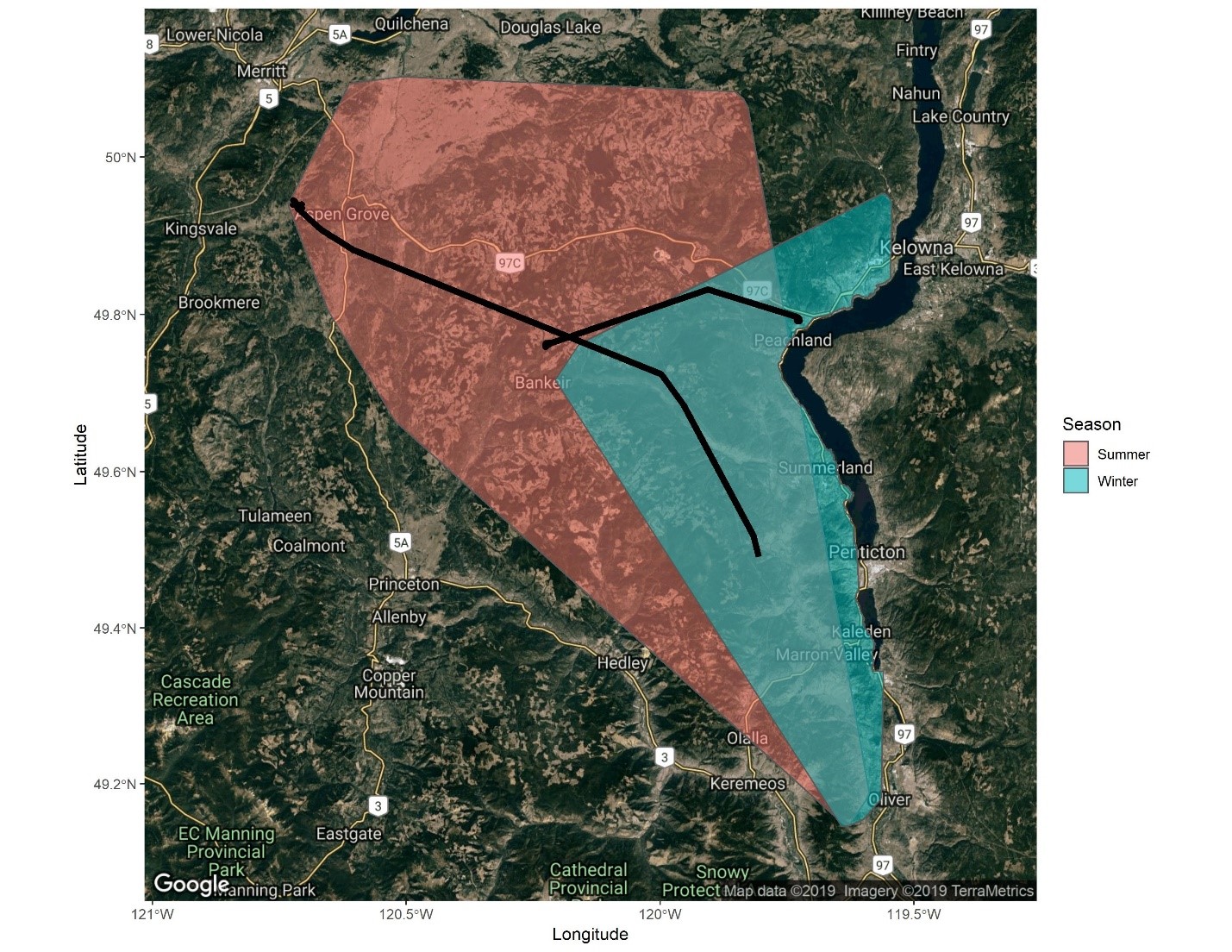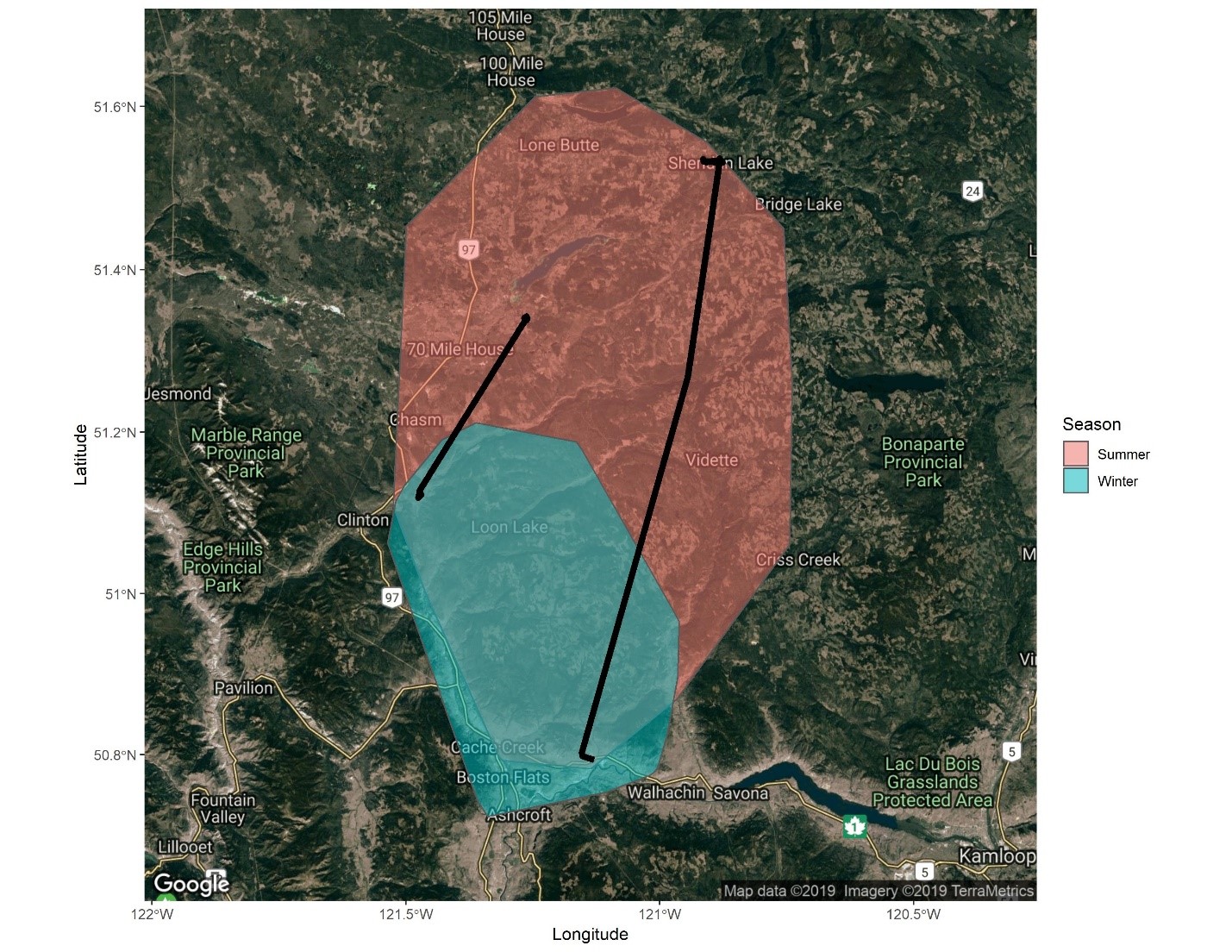The Southern Interior Mule Deer project continues to march along, adding additional components to the project and techniques. This spring saw the deployment of 155 trail cameras across our study areas, and a number of neonate (newborn mule deer) collared shortly after birth. The following is a brief update of what we’ve done, what we’re doing and how you can get involved.
Pregnancy and Twinning
 One of the questions we wanted to look at early on was the effect of hunting seasons on populations in the study areas. One of the first large purchases was two ultrasounds which would allow us to assess pregnancy and twinning rates as well as body condition. As of spring 2019, our team had documented pregnancy rates of 93% and twinning rates of >69%. These metrics are both considered very good for mule deer.
One of the questions we wanted to look at early on was the effect of hunting seasons on populations in the study areas. One of the first large purchases was two ultrasounds which would allow us to assess pregnancy and twinning rates as well as body condition. As of spring 2019, our team had documented pregnancy rates of 93% and twinning rates of >69%. These metrics are both considered very good for mule deer.
This spring, our research team shortened the time between GPS location updates and was able to identify when our pregnant does were clustering (going into labour). This allowed our team to go in and capture and collar neonates (newborns) to identify survival rates right after fawns are born. While this technique has seen varied success in North America, it worked very well for our team.
Adult females (does) and juveniles (fawns) are what drive mule deer populations. The good news is our deer are pregnant and have high twinning rates; that means that it is unlikely our buck hunting seasons are having a negative effect on our mule deer population trajectory. The bad news is, in some of our areas our does seem to have low survival rates.
Mortalities
As of October 2019, we have the following does and yearlings (fawns from spring of 2019) collared in our study areas:
Boundary: 22 does, 5 yearlings,
Cache Creek: 26 does, 3 yearlings,
West Okanagan: 27 does, 12 yearlings
Generally speaking, our deer in the Boundary have very low survival rates, whereas Cache Creek have high survival rates, and the West Okanagan is somewhere in between. Survival of adult does after the first year of the project was 69% in the Boundary, 95% in Cache Creek, and 83% in the West Okanagan. We will have a better idea of fawn survival by spring of 2020. The breakdown of mortality sources in our study areas are as follows:
Boundary Mortalities = 22
Cougar 15, Canid 1, Coyote 1, Drowning 1, Apparent Grizzly Bear 1, Unknown 1, Vehicle 2
Cache Creek Mortalities = 7
Black Bear 1, Cougar 2, Coyote 1, Unregulated harvest 2, Health 1
West Okanagan Mortalities = 15
Cougar 5, Apparent cougar 3, Coyote 1, Predation 1, Starvation 2, Unknown 1, Vehicle 2
Migration
GPS collared deer help us understand how, when and why our deer move across the landscape. Over time we hope to gather evidence which will help us advocate to maintain and restore migratory routes, and critical habitat. Here is a map of the summer and winter ranges in each of our three areas. These maps included migrations of two randomly selected deer in each study area (black line).



Our longest migrant this year was in the Okanagan, a doe which was collared near Apex Mountain (west of Penticton) last January, and May 1 decided to head for summer range, arriving west of Aspen Grove on May 12th, covering 102 kms in a straight line.
By mid-October this year, nearly all the collared deer in each study area were back in their winter range.
Our Team
Our team continues to grow as we add funding partners, collaborators, and a growing list of dedicated volunteers. Volunteer opportunities to date have included baiting deer traps, fixing deer traps, deer capture and collaring deer, mortality investigations, and trail camera placement across our three study areas. Our volunteers have been amazing spending thousands of hours chipping in where they can.
This spring 40 volunteers were trained up and put out 155 trail cameras across our three study summer areas which encompasses ~40,000 km2. The cameras will be moved twice annually to cover both summer and winter range. This fall volunteers were out pulling memory cards and moving trail cameras to winter range in our study areas. The effort has been amazing, and we can’t wait to see what the pictures turn up.
The trail cameras will provide valuable insight into the project, including the effect of roads, there density, timber harvest, wildfires on habitat used by mule deer, other ungulates, and their shared predators.

Dr. Adam Ford, Cailyn Glasser (Biologist with ONA), Dave Carleton (BCWF), Chloe Wright PHD Student UBCO in charge of data collection and helping with collaring and Darryl Frasier BCWF Volunteer
Funding
The Southern Interior Mule Deer Project is the largest collaborative project BC has ever had. Volunteers, the Okanagan Nation Alliance, BC Wildlife Federation and Clubs, Fish, Wildlife and Habitat Branch, University of British Columbia, and University of Idaho have contributed tens of thousands of hours and thousands of dollars to this project.
Our funders include: The Habitat Conservation Trust Foundation, BC Timber Sales, BC Fish, Wildlife and Habitat Branch, University of Idaho, University of British Columbia Okanagan, Kettle Wildlife Association, Mission & District Rod & Gun Club, North Shore Fish & Game Club, Southern Okanagan Sportsmen’s Association, East Kootenay Hunters Association, Kelowna & District & Game Club, Kamloops and District Fish and Game Association, OCEOLA Fish and Game Club, Pemberton Wildlife Association, Summerland Sportsman’s Association, Traditional Bowhunters of BC, Vernon Fish & Game Association, Grand Forks Wildlife Association, and Keremeos-Cawston Sportsman Association.
This does not include well over 100 volunteers who have donated time, experience and funding to help move this project forward. Without them this project would not have happened.
The project is still looking for funding. We are currently in the process of funding Sam Foster, PhD candidate at the University of Idaho, whose primary role will be looking at predator and prey occupancy through our trail camera network and how habitat affects our deer. We are still looking to offset capture costs, mortality investigations, data fees for collared deer, and trail cameras, cards and batteries as well as travel and accommodation.
Looking Ahead
As we continue to put the pieces together on how, when, where our deer move, which habitats they select, and what the prey and predator communities look like, we will be able to understand how to recover our mule deer populations and advocate for changes in wildlife and land management. This is foundational work that will benefit mule deer and future generations of conservationists.
If you’re interested in donating to the project, you can do so through the BCWF website. Select Southern Interior Mule Deer Project under designation and we will issue you a tax receipt. If you’re looking to volunteer, please send an email to southerninteriormuledeer@gmail.com.
The list of volunteers is getting bigger every month, but we are doing our best to try to find opportunities for everyone
